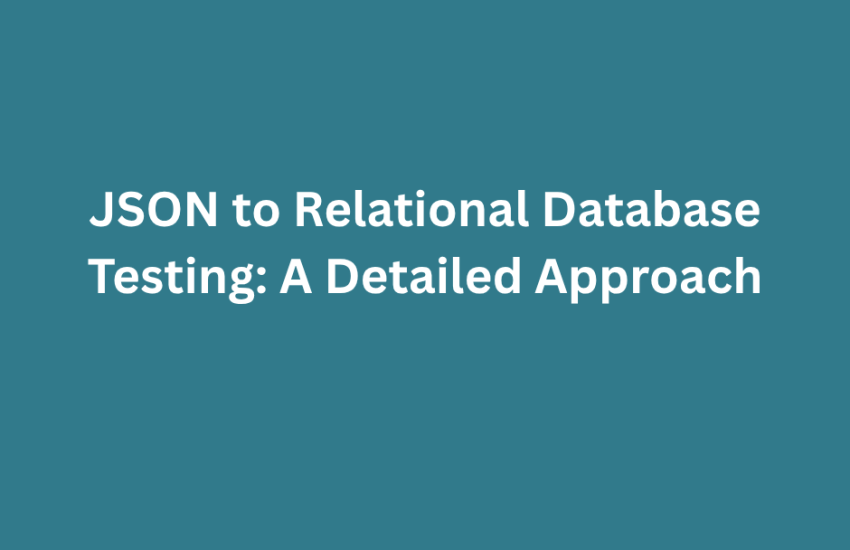Overview
This testing plan describes the steps to ensure that data is correctly transferred from JSON format into a relational database. It checks that the data is accurate, consistent, and properly linked while maintaining the relationships between the JSON data and the database tables.
Approach and Objectives:
- Validate the structure of the JSON data against the database schema.
- Ensure accurate data transfer and confirm proper relationships between JSON data and relational tables.
- Perform manual queries to verify data storage correctness.
- Identify and resolve inconsistencies or missing records.
- Ensure smooth data flow from JSON to the relational database.
- Maintain data integrity, consistency, and accuracy throughout the process.
- Thoroughly test that updates, insertions, and deletions are correctly handled without errors.
Here is a comprehensive overview of a plan that can be used to test data transfer from JSON to a database.
1. Schema Validation
Ensure that the structure of the JSON data matches the database schema, verifying that fields, data types, and relationships align between the two.
Actions:
Compare the JSON schema with the relational database schema.
- Verify Field Names: Ensure that all field names in the JSON data match the database column names if these are the requirements, and we can even check the mapping and then do the field verification.
- Verify Data Types: Check that data types in the JSON (e.g., integers, strings, dates) match the database column types.
- Verify Required Fields: Ensure that all mandatory fields in the JSON data are present and correctly mapped to corresponding database fields.
Example:
JSON:
{
"policy_id": 12345,
"policyholder_name": "John Doe",
"premium_amount": 1500
}Test Criteria:
- Ensure all required fields are present in both the JSON and database.
- Ensure data types match (e.g., premium_amount in the JSON as DECIMAL(10,2) in the database).
2. Data Integrity Testing
Validate that data is correctly mapped and integrity is maintained, especially for primary and foreign key relationships.
Actions:
- Validate Primary Keys: Ensure that primary keys in the JSON are present and unique in the database.
- Validate Foreign Keys: Verify that foreign key relationships between the JSON data and database records are correct.
- Validate Data Linkage: Ensure that linked records across different tables (e.g., policies, policyholders, premiums) maintain correct relationships.
Example:
Foreign Key Test:
Insert a record into the policies table, ensuring the policyholder_id links correctly to the policyholders table.
Test Criteria:
- Make sure primary and foreign key rules are followed when adding data.
- Ensure that updates and deletions automatically apply to related tables as needed.
3. Data Consistency Verification
Ensure that the data in the JSON matches the corresponding records in the database, including important details like policyholder information, coverage details, premium amounts, and policy dates.
Actions:
- Compare JSON Records with Database Records: Ensure that key fields (e.g., IDs, policyholder names, premium amounts, expiration dates) match between JSON and the database.
- Review Policy Details: Ensure that details like coverage type, premium, and policy expiration are accurate.
- Validate Accurate Values: Check that critical values (e.g., coverage, premium, dates) are consistent across both systems.
Example:
JSON Record:
{
"policy_id": 12345,
"coverage_type": "Full",
"premium_amount": 1500,
"policy_expiration": "2025-12-31"
}Test Criteria:
- Check for consistency between fields like policyholder_name, premium_amount, coverage_type, etc.
- Can also perform queries to compare each value between the JSON data and the database.
4. Data Mapping & Relationship Testing
Ensure that the relationships between entities in the JSON are correctly mapped and maintained in the relational database.
Actions:
- Test Entity Relationships: Ensure that JSON data correctly maps to relationships between tables (e.g., a policy should map to a policyholder and coverage).
- Ensure Data Integrity in Relationships: Confirm that one-to-many and many-to-many relationships are properly handled and that relational integrity is maintained.
Test Criteria:
- Ensure the relationships (e.g., between policies and policyholders) are correctly reflected in both the JSON and database.
5. Data Accuracy Testing
Verify that the data is accurate and free from errors like duplicate entries or missing records.
Actions:
- Check for Duplicates: Verify that no duplicate records are present in both the JSON data and the database.
- Ensure Completeness: Ensure that no records are missing from the database after the JSON data has been processed.
Example:
Check for Duplicates: We can use the SQL queries to find duplicate entries and even can find this manually.
Test Criteria:
- Ensure the absence of duplicate records in both systems.
- Ensure that all records from the JSON data are present in the database.
6. CRUD Operations Testing
Ensure that CRUD (Create, Read, Update, Delete) operations work as expected for both JSON and database interaction.
Actions:
- Insert JSON Data: Insert JSON data into the database and verify storage.
- Update JSON Data: Modify existing JSON records and verify the changes are correctly updated in the database.
- Delete Records: Ensure that when records are deleted in the UI or database, they are accurately reflected.
Test Criteria:
- Validate that data entered in JSON is correctly stored, updated, and deleted in the database.
7. Other Testing Cases
Test how the system behaves under various edge cases that are not considered as a part of other cases.
Actions:
- Handle Invalid JSON Structures: Test how the system handles incorrect or malformed JSON data.
- Performance Testing: Test system performance with large data files, ensuring it can handle bulk inserts, updates, and deletions without performance degradation.
Example:
- Invalid JSON Structure:
If the JSON is missing required fields or has incorrect data types, ensure the system throws an appropriate error.
Test Criteria:
- Validate that the system rejects invalid JSON.
- Ensure performance is acceptable when processing thousands of JSON records at once.
8. Performance Testing
Ensure the system performs well when processing large datasets.
Actions:
- Bulk Data Handling: Test how the system handles bulk data inserts from JSON files.
- Load Testing: Evaluate performance under heavy load, processing thousands of JSON records at once.
Test Criteria:
- Ensure system scalability by processing large datasets without degradation in performance.
******Test Documentation Template******
For each test case, the following template should be used for clear documentation:
- Test Case ID: [Unique identifier]
- Test Objective: [Test objective]
- Test Description: [What the test will verify]
- Test Steps: [Step-by-step instructions for performing the test]
- Expected Result: [Expected outcome of the test]
- Actual Result: [Actual outcome of the test]
- Pass/Fail Criteria: [Criteria to determine if the test passed or failed]
- Remarks: [Any additional notes or comments]




